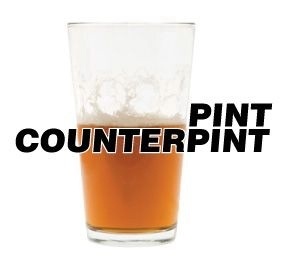 Pint/CounterPint was created when Adam Watson (Against the Grain Brewery) wrote a loving response to the first Baylor on Beer article, Know your Enemy, written by Roger Baylor (New Albanian Brewing Company). At first we laughed whole-heartedly and admired the conviction and stance of both parties, and then we thought, “Hey, wait a minute… remember that old 60 Minutes segment called Point/Counterpoint?”
Pint/CounterPint was created when Adam Watson (Against the Grain Brewery) wrote a loving response to the first Baylor on Beer article, Know your Enemy, written by Roger Baylor (New Albanian Brewing Company). At first we laughed whole-heartedly and admired the conviction and stance of both parties, and then we thought, “Hey, wait a minute… remember that old 60 Minutes segment called Point/Counterpoint?”
For those of you that don’t, Point/Counterpoint was a segment of the CBS Television News Magazine, 60 Minutes. Point/Counterpoint was a debate between spokespeople for the political right and left, respectively. This segment pioneered a format that would later be adapted by CNN for its Crossfire show. LouisvilleBeer.com adopted the format for an online debate between Adam and Roger. Welcome to Round 5. DING!
…………………………………………
Pint/CounterPint 5:1
Are collaborations between breweries valuable apart from their usefulness in marketing to RateBeer.com? – PRO
By: Roger Baylor, New Albanian Brewing Company
Collaborations are valuable and should be encouraged.
Modern beer appreciation is driven by habits widely borrowed, albeit for the most part unwittingly, from the world of the oenophile, where personal standards of judgment have been supplanted by the sheer cumulative weight of expert testimony.
Accordingly, several well-known beer ratings sites take all the frustration and guesswork out of one’s own beer tasting experience by outsourcing olfactory interpretation to the helpful mouths of the reigning collective zeitgeist – as though lemmings were provided free WiFi and an electronic copy of “Cliff Diving at a Glance” just prior to freely choosing their point of debarkation.
But I digress.
As with other fields of entertainment – cooking, pornography and hip hop spring to mind – craft beer now has its own superstars, a category embracing brewing companies as larger entities, as well as the individuals behind them, often the owners, although sometimes brewers.
Taking this evolving star treatment a step further, a few years back there began the now familiar practice of collaboration, as gratefully shorn of the word’s negative connotations in connection with World War II and Nazis in places like France, now implying a coming together of great brewing minds to conjure beers that bring qualities of one or more participants together, in somewhat equal measure, to a brand new beer.
If distribution networks are sufficiently far flung, the resulting collaboration beer might find itself quickly touted by the voracious denizens of social media, enhancing interest in the cooperating brewery’s everyday, more widely available beers – although it would be unspeakably crass of me to suggest that marketing budgets preface sincerity in the pristine world of craft beer.
An early example of collaboration between well-regarded breweries and high-visibility owners came in 2009, with Dogfish Head and Sierra Nevada brewing Life and Limb. America’s East Coast was represented by maple and birch syrup, and the West Coast by estate-grown barley. House ale yeasts from both breweries fermented the 10% beer, and then, in the grand tradition of session beer, Sierra Nevada utilized the batch’s second runnings to brew Limb and Life, weaker by half than its big brother, yet still flavorful.
Another was Collaboration Not Litigation Ale, wherein Avery (Colorado) and Russian River (California) decided to work together with separate beers of the same name, instead of doing the usual American Big Corporation Tango in court.
There have been so many collaborations since then that you’d have to deploy a data base like RateBeer’s or Beer Advocate’s just to keep track of them. New Holland collaborated with a delicatessen in Chicago, my NABC with Charlestown Pizza Company (later with Louisville Beer Store and De Struise, and then with Flat12), and Adam Watson’s own Against the Grain with Mikkeller. Numerous chefs and foodies have gotten into the act, too.
But don’t get the idea that my flippancy implies disapproval. In fact, these collaborations bring Craft Beer Nation’s brightest brewing brethren together to exchange new ideas and to freshen the genre’s inspiration, illustrating that in a beer market still heavily skewed toward the light lager ethos of the dominant industrial brewing consortiums, there is little cut-throat competition between craft brewers.
Rather, there is innovation, cooperation and combined action, and in the process, a great deal of plain, good old-fashioned fun … and when the mash tun’s finished being shoveled, having fun is what sets this business apart from the others. Collaborate to your heart’s content, guys; I’ll be happy to sample the intriguing results.
Pint/CounterPint 5:2
Are collaborations between breweries valuable apart from their usefulness in marketing to RateBeer.com? – CON
By: Adam Watson, Against the Grain Brewery
The Pol Pot Scenario
Time to pay the piper, as it were. As you may have noticed in the last installment of this semi-irregular battle of the twits, I got the good side. You may also notice that I foretold my own doom for this installment. In what I will now deem “The Pol Pot Scenario”, I will proceed to argue that collaborations between breweries have no value apart from their usefulness in marketing to ratebeer.com and other such outlets.
I could start off with some brief history of collaborations between respected breweries, but that is a story already told by our Resident Windbag, so I’ll not reiterate. Instead, let us examine the only thing that talks more than Roger: money. Of course we all do it for the art, but no starving artist makes it to a 25th anniversary celebration. In the end, whatever our reasoning behind brewing, we only continue to do it because it makes us money. Usually not a lot of money but money none-the-less. With that as a standard, a successful collaboration is a rare thing indeed. Sierra Nevada and Dogfishhead can have a great time hanging out and drinking beers. The two L&L’s may even turn out to be tasty beverages, but did they make the next Sierra Nevada Pale Ale? No. Will it outsell 60 Minute IPA? Nossir. Was it worth the effort and resources? Maybe, but only if it gets a rise out of the neckless goobers who lose their shit if they can’t fit you into one of the styles on the dropdown menu for their ratebeer.com account.
My point is this: the next great innovation in beer has never been discovered via collaboration. The truly great new brews are a result of inventive brewers who have taken the time to become intimately familiar with the subtle details of their favorite ingredients and with the inescapable quirks of their brewing system. Where does it leak? How much water boils off in X minutes? Which part of the vessel is warmer or colder? Which pumps do you have to pulse instead of just turn on to make sure you clear the last of the sanitizer? The brewer only knows these things about his or her own system, and no one else knows them. If Emeril Lagasse stepped into my kitchen, he would probably make a plate of crap. Well, maybe not, but it’s an extreme example. Cut me some slack. That plate would not sell for much, no matter how many notches he kicked it up.
Collaborations can be fun. Brewers get together to hang around and say things like, “Man, you ought to get some rakes for your mash tun!” and “I still can’t believe you don’t have air conditioning up here,” stand in the way, drink your beer, and laugh uncomfortably at your fart jokes. I know that may not sound like fun, but brewers can be a twisted folk. Collaborators don’t actually brew with you. It’s not their damn kitchen. They don’t know if you like your clamps facing left or right. They don’t know that the gray hose is for beer, and the red hose is for water. They may not even have experience with the staple ingredients you take for granted. Paradoxically, collaboration is basically masturbation. It may be mutual, everyone may enjoy it, and you may even be able to sell it on the internet, but you aren’t gonna make your next baby that way. And that’s why collaborations are stupid.
Phew. Glad that’s over. Time to go check on that beer we brewed with De Molen a few weeks ago.





